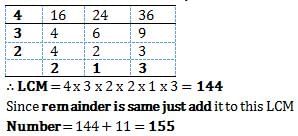GMAT Exam > GMAT Questions > What least number when divided by 36, 24 and ...
Start Learning for Free
What least number when divided by 36, 24 and 16 leaves 11 as remainder in each case?
- a)36
- b)133
- c)144
- d)155
- e)166
Correct answer is option 'D'. Can you explain this answer?
Verified Answer
What least number when divided by 36, 24 and 16 leaves 11 as remainder...
Here least number is needed that means we need the LCM
We must first find LCM of 36, 24 and 16

We must first find LCM of 36, 24 and 16

Most Upvoted Answer
What least number when divided by 36, 24 and 16 leaves 11 as remainder...
Solution:
To find the least number that leaves the same remainder when divided by 36, 24 and 16, we need to find the LCM of 36, 24 and 16.
Prime factorization of 36 = 2^2 × 3^2
Prime factorization of 24 = 2^3 × 3^1
Prime factorization of 16 = 2^4
LCM of 36, 24, and 16 is 2^4 × 3^2 = 144
Therefore, any number that leaves the remainder of 11 when divided by 36, 24, and 16 is a multiple of 144 plus 11.
The least multiple of 144 greater than 11 is 144 itself. So, the least number that leaves the remainder of 11 when divided by 36, 24, and 16 is 144 + 11 = 155.
Hence, the correct answer is option D) 155.
To find the least number that leaves the same remainder when divided by 36, 24 and 16, we need to find the LCM of 36, 24 and 16.
Prime factorization of 36 = 2^2 × 3^2
Prime factorization of 24 = 2^3 × 3^1
Prime factorization of 16 = 2^4
LCM of 36, 24, and 16 is 2^4 × 3^2 = 144
Therefore, any number that leaves the remainder of 11 when divided by 36, 24, and 16 is a multiple of 144 plus 11.
The least multiple of 144 greater than 11 is 144 itself. So, the least number that leaves the remainder of 11 when divided by 36, 24, and 16 is 144 + 11 = 155.
Hence, the correct answer is option D) 155.
Free Test
FREE
| Start Free Test |
Community Answer
What least number when divided by 36, 24 and 16 leaves 11 as remainder...
Explain briefly about answer

|
Explore Courses for GMAT exam
|

|
Similar GMAT Doubts
What least number when divided by 36, 24 and 16 leaves 11 as remainder in each case?a)36b)133c)144d)155e)166Correct answer is option 'D'. Can you explain this answer?
Question Description
What least number when divided by 36, 24 and 16 leaves 11 as remainder in each case?a)36b)133c)144d)155e)166Correct answer is option 'D'. Can you explain this answer? for GMAT 2025 is part of GMAT preparation. The Question and answers have been prepared according to the GMAT exam syllabus. Information about What least number when divided by 36, 24 and 16 leaves 11 as remainder in each case?a)36b)133c)144d)155e)166Correct answer is option 'D'. Can you explain this answer? covers all topics & solutions for GMAT 2025 Exam. Find important definitions, questions, meanings, examples, exercises and tests below for What least number when divided by 36, 24 and 16 leaves 11 as remainder in each case?a)36b)133c)144d)155e)166Correct answer is option 'D'. Can you explain this answer?.
What least number when divided by 36, 24 and 16 leaves 11 as remainder in each case?a)36b)133c)144d)155e)166Correct answer is option 'D'. Can you explain this answer? for GMAT 2025 is part of GMAT preparation. The Question and answers have been prepared according to the GMAT exam syllabus. Information about What least number when divided by 36, 24 and 16 leaves 11 as remainder in each case?a)36b)133c)144d)155e)166Correct answer is option 'D'. Can you explain this answer? covers all topics & solutions for GMAT 2025 Exam. Find important definitions, questions, meanings, examples, exercises and tests below for What least number when divided by 36, 24 and 16 leaves 11 as remainder in each case?a)36b)133c)144d)155e)166Correct answer is option 'D'. Can you explain this answer?.
Solutions for What least number when divided by 36, 24 and 16 leaves 11 as remainder in each case?a)36b)133c)144d)155e)166Correct answer is option 'D'. Can you explain this answer? in English & in Hindi are available as part of our courses for GMAT.
Download more important topics, notes, lectures and mock test series for GMAT Exam by signing up for free.
Here you can find the meaning of What least number when divided by 36, 24 and 16 leaves 11 as remainder in each case?a)36b)133c)144d)155e)166Correct answer is option 'D'. Can you explain this answer? defined & explained in the simplest way possible. Besides giving the explanation of
What least number when divided by 36, 24 and 16 leaves 11 as remainder in each case?a)36b)133c)144d)155e)166Correct answer is option 'D'. Can you explain this answer?, a detailed solution for What least number when divided by 36, 24 and 16 leaves 11 as remainder in each case?a)36b)133c)144d)155e)166Correct answer is option 'D'. Can you explain this answer? has been provided alongside types of What least number when divided by 36, 24 and 16 leaves 11 as remainder in each case?a)36b)133c)144d)155e)166Correct answer is option 'D'. Can you explain this answer? theory, EduRev gives you an
ample number of questions to practice What least number when divided by 36, 24 and 16 leaves 11 as remainder in each case?a)36b)133c)144d)155e)166Correct answer is option 'D'. Can you explain this answer? tests, examples and also practice GMAT tests.

|
Explore Courses for GMAT exam
|

|
Signup for Free!
Signup to see your scores go up within 7 days! Learn & Practice with 1000+ FREE Notes, Videos & Tests.
























